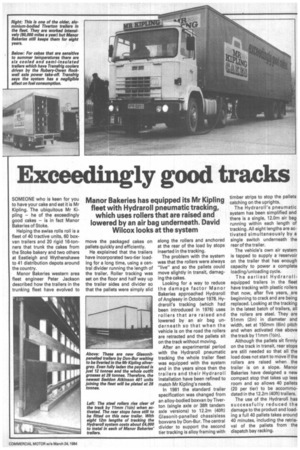Exceedingly good tracks
Page 41

If you've noticed an error in this article please click here to report it so we can fix it.
SOMEONE who is keen for you to have your cake and eat it is Mr Kipling. The ubiquitous Mr Kipling — he of the exceedingly good cakes — is in fact Manor Bakeries of Stoke.
Helping the swiss rolls roll is a fleet of 40 tractive units, 60 boxvan trailers and 20 rigid 16-tonners that trunk the cakes from the Stoke bakery and two others at Eastleigh and Wythenshawe to 41 distribution depots around the country.
Manor Bakeries western area fleet engineer Peter Jackson described how the trailers in the trunking fleet have evolved to move the packaged cakes on pallets quickly and efficiently.
He explained that the trailers have incorporated two-tier loading for a long time, using a central divider running the length of the trailer. Roller tracking was set on the floor and half way up the trailer sides and divider so that the pallets were simply slid along the rollers and anchored at the rear of the load by stops inserted in the tracking.
The problem with the system was that the rollers were always "live" and so the pallets could move slightly in transit, damaging the cakes.
Looking for a way to reduce the damage factor Manor Bakeries approached Hydraroll of Anglesey in October 1978. Hydraroll's tracking (which had been introduced in 1976) uses rollers that are raised and lowered by an air bag underneath so that when the vehicle is on the road the rollers are retracted and the pallets sit on the track without moving.
After an experimental period with the Hydraroll pneumatic tracking the whole trailer fleet was equipped with the system and in the years since then the trailers and their Hydraroll installation have been refined to match Mr Kipling's needs.
In 1981 the standard trailer specification was changed from an alloy-bodied boxvan by Tiverton (single axle or 38ft tandem axle versions) to 12.2m (40ft) Glasonit-panelled chassisless boxvans by Don-Bur. The central divider to support the second tier tracking is alloy framing with timber strips to stop the pallets catching on the uprights.
The Hydraroll's pneumatic system has been simplified and there is a single, 12.0m air bag running within each length of tracking. All eight lengths are activated simultaneously by a single switch underneath the rear of the trailer.
The vehicle's own air system is tapped to supply a reservoir on the trailer that has enough capacity to power a complete loading/unloading cycle.
The earliest Hydrarollequipped trailers in the fleet have tracking with plastic rollers that now, after five years, are beginning to crack and are being replaced. Looking at the tracking in the latest batch of trailers, all the rollers are steel. They are 51mm (2in) in diameter and width, set at 150mm (6in) pitch and when activated rise above the track by 11mm (1/2in).
Although the pallets sit firmly on the track in transit, rear stops are still needed so that all the load does not start to move if the rollers are raised when the trailer is on a slope. Manor Bakeries have designed a new compact stop that takes up less room and so allows 40 pallets (20 per tier) to be accommodated in the 12.2m (40ft) trailers.
The use of the Hydraroll has successfully reduced the damage to the product and loading a full 40 pallets takes around 40 minutes, including the retrieval of the pallets from the dispatch bay racking.
























































































